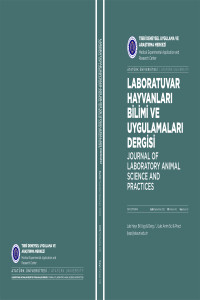Research Article
Issue Editorial Board










 Web
Web







 Web
Web






 Web
Web



 Web
Web

Aim & Scope
Journal of Laboratory Animal Science and Practices aims to contribute to national and international knowledge in its field.
Journal of Laboratory Animal Science and Practices is the double blind peer-reviewed scientific publication of Atatürk University-Medical Experimental Application and Research Center and is published twice a year, in March and September. The abbreviated name of the journal is “Lab Hayv Bil Uyg Derg / J Lab Anim Sci Pract”. The Journal of Laboratory Animal Science and Practice publishes original article types in the field of laboratory animals.
Journal of Laboratory Animal Science and Practices publishes original articles (original research article, case report and reviews) in the field of laboratory animals such as rabbits, rats and mice.
Subdomains; Faculty of Medicine, Faculty of Veterinary Medicine, Faculty of Dentistry, Faculty of Pharmacy, Faculty of Fisheries and Aquaculture, Agriculture and Faculty of Science.
Author Guidelines
INFORMATION TO AUTHORS
Journal of Laboratory Animal Science and Practices is the double blind peer-reviewed scientific publication of Atatürk University Medical Experimental Application and Research Center and is published twice a year, in March and September. The abbreviated name of the journal is "Lab Hayv Bil & Uyg Derg" / J Lab Anim Sci Pract.
In this journal, "Laboratory animals in the fields of Medicine, Veterinary Medicine, Dentistry, Aquaculture, Science, Agriculture, Pharmacy and similar fields using laboratory animals that have been prepared in one of the Turkish or English languages and have not been published in another journal or presented simultaneously to another journal. Original research articles, case reports and reviews prepared in the fields in which they are used are published.
Ethics committee approval is required for all original research articles submitted to the Journal of Laboratory Animal Science and Practice and using laboratory animals as material. The institution from which the ethics committee approval was obtained and the approval number should be written in the Material and Method section of the article. The editorial board has the right to request the ethics committee approval document.
The authors are obliged to comply with the copyright-terms regarding the material taken and used from other sources and to sign the contract expressing the transfer of the copyright to the journal.
Any responsibility arising from the articles in the journal belongs to the author(s).
Articles are sent to at least two referees for evaluation. In the article acceptance process, if the opinions of the two referees differ, a decision is made by taking the opinion of the editor or a third referee.
The corresponding author has to send the "Article Control Form" together with the article to be sent to the Journal of Laboratory Animal Science and Practices for publication.
In the articles sent to Journal of Laboratory Animal Science and Practices, no change in the name of the author or the order of the name is made in the article, from the moment the article evaluation process begins.
The article and article control form received by the Editor of the Journal of Laboratory Animal Science and Practices are subjected to preliminary evaluation by the journal editor. The editorship has the right to reject the article according to the preliminary evaluation result or to request correction before it is subject to referee evaluation.
In accordance with the ethical policy of the Journal of Laboratory Animal Science and Practices, plagiarism is not tolerated. All articles submitted to the journal are checked for similarity using appropriate software. Articles with a similarity rate of more than 15% (excluding references) are rejected.
In order for the articles related to "Notifiable Diseases" specified by the Ministry of Agriculture and Forestry to be evaluated, The permission letter obtained from the Ministry of Agriculture and Forestry must be submitted to the Journal Editor.
PREPARATION OF THE ARTICLE
1. Articles should be written on A4 file paper (single-sided), double-spaced, with 3 cm margins, and the number of pages, including figures, tables and references, should not exceed 16 pages in original scientific research and reviews, and 5 pages in short scientific studies such as case reports.
2. The article should be prepared in Microsoft Word 6.0 or higher, in Calibri character and in 12 font size. Article Title Page and Main Text should be prepared and uploaded as separate Word files.
3. Line numbers (starting from the 1st page of the article continuously) and page numbers (bottom and center of the page) should be added to the article.
4. Explanatory information about the article (thesis, project, etc.) should be written as a superscript * at the end of the article title and explained in italics under the article title.
5. Trade names of substances and products subject to research should not be used.
For Original Scientific Research Articles:
Cover Page: The first page of the article should consist of the title, the names and addresses of the authors, the e-mail addresses of the authors, the contact information of the responsible author and, if any, descriptive information about the article.
Title: Turkish and English titles should be written in capital letters only. If the language of the article is Turkish, the title should be written first in Turkish and then in English. If the language of the article is in English, the title should be written in English and then Turkish.
Author Names and Addresses: Only the initials of the author(s) name and surname (without academic title) should be written in capital letters and centered under the title. Corresponding author should be marked with (*), numbers should be added to the upper right corner of the authors' names, and these numbers should be used in the addresses section. At the address of the authors; The institution, unit, city and country to which it is affiliated should be specified. ORCID numbers of all authors should be indicated on the cover page.
E-mail Addresses of Authors: Names and e-mail addresses of all authors whose names are included in the article should be written.
Corresponding Author Contact Information: Information including name, surname, e-mail, address, telephone, GSM and fax numbers of the responsible author of the article should be written.
Explanatory Information About the Article: Explanatory information (thesis, project, etc.) about the article, if any, should be explained in italics at the end of the first page.
Main Document Page 1: The 1st page of the article should contain Turkish abstract and keywords, and English abstract and keywords. If the article is written in Turkish, primarily Turkish abstract and keywords; If the language of the article is in English, the abstract and keywords in English should be presented first.
Summary: It should briefly include the purpose, material, method, findings and results. The number of words to be used in the abstracts should be between 170-200 words and should be written with single line spacing.
Keywords: Keywords should be selected from “Turkish Science Terms” (http://www.bilimterimleri.com/tr-index.html). There should be a maximum of 5. Turkish keywords should be listed alphabetically according to Turkish, and English keywords should be listed alphabetically according to English.
A (,) sign should be placed between each keyword, and a (.) sign should be placed after the last keyword.
Second Page: The article should be completed as “INTRODUCTION”, “MATERIALS and METHOD”, “FINDINGS”, “DISCUSSION and CONCLUSION”, Conflict of interest and “REFERENCES” sections starting from the third page.
Results and discussion can be given together. Acknowledgments can be added if necessary. Section titles should be written in capital letters. Sub-headings of the sections should be written with only the first letters in capital letters. All headings should be written in bold and 12 point font.
Statistical Analysis information: should be given under the title of "Statistical Analysis" at the end of the MATERIAL and METHODS section of the article.
Units and Abbreviations: The explanation of each abbreviation should be given in the first place in the text. International Standard units (SI-system) should be used for units and measures. Genus and species names should be written in italics. Points should be used in the numerical and statistical data used in the article (example: 44.5; 0.82; 97.7%; P<0.01 etc.).
Tables and Figures: Tables and Figures should be sent separately from the main document.
Tables should have a maximum of 35 lines to fit a vertical page of 7 cm, and a maximum of 25 lines to fit a horizontal page of 15 cm. Figures should be prepared in jpeg, tiff, bmp or gif formats and with a resolution of at least 150 dpi so that they are not blurred, the texts and markings written on the figure should not exceed 12 points with the "Calibri" font in image processing programs (Photoshop, paint, etc.). Graphics should be prepared in doc, docx, xls or xlsx format, not in picture format. Figures, graphics, photographs and pictures should be expressed as figures in the titles and in the text. Figures and tables should be numbered according to their order in the text and should be written without abbreviation in the text (eg Figure 1, Table 1).
Titles and explanations of tables and figures should be added in both Turkish and English. Any abbreviations used in tables and figures should be explained under the tables and figures.
Conclusion: The conclusion/result of the article should be stated with a single paragraph starting with the phrase "as a result…" at the end of the "Discussion and CONCLUSION" section.
For Case Reports:
The cover page and first pages should be prepared as described in the original scientific research articles. The number of words to be used in the abstracts should not be less than 120 and should be written with single line spacing.
Starting from the second page, it should be completed as “INTRODUCTION”, “CASE REPORT” (materials, methods and findings should be mentioned under the title of case report), “Discussion and Conclusion”, “Conflict of Interest”, and “REFERENCES”.
Statistical analysis information, units and abbreviations, tables and figures, if any, should be presented in the case report as described in the section of scientific research articles.
The conclusion/result of the case report should be stated with a single paragraph starting with the phrase “as a result…” at the end of the “Discussion and CONCLUSION” section.
For Reviews:
The first and second pages should be prepared as described in the original scientific research articles. The summary prepared for the reviews should consist of information about the subject of the review and the purpose of the review. The number of words to be used in the abstracts should be between 170-200 and should be written with single line spacing.
The review should start with "INTRODUCTION" from the second page, continue with subheadings to be determined by the author/s, and be completed with "CONCLUSION", Conflict of interest and REFERENCES.
Units and abbreviations, tables and figures, if any, should be presented in the review as described in the section of scientific research articles.
The conclusion of the compilation should be stated under the CONCLUSION title just before the REFERENCES section.
Conflict of Interest
Regardless of the type of the article sent to the journal (original research article, case report, review), the title of Conflict of Interest should be added before the references title in the article and the statement "Authors declare that there is no conflict of interest" should be written.
References
The number of references used should not be less than 10 for case reports, less than 20 for research articles, and no more than 45 for all types of articles. Regardless of the type of article (original research article, case report, review), at least one-third of the sources used (based on the year the article was sent) should belong to the last 3 years. Regardless of the type of article (original research article, case report, review), references should be presented as follows:
In the text: In all quotations in the text, the surname of the author and the year of publication should be given, eg: (Aydın, 2017). If the authors are two names, both names are referenced eg (Aydın & Timurkan, 2015), if the authors are 3 or more: the first author's name should be used followed by “et al.” If the article is in English, “et al.” should be written. for example: (Aydin et al., 2021). If more than one author is cited, their names are arranged chronologically, and if their publication is in the same year - alphabetically.
Where the author's name will be used, the surname of the author and the year of publication Aydın (2015), Aydın et al. (2016) should be written as in the examples.
In the References Section:
References numbered in the text should be listed in alphabetical order in the references section of the article.
The abbreviation of the name of the journal should be used in writing the names of the scientific journals cited.
If the source article is; Barbour AH., Rampling A., Hormaeche CE., 2001. Variation in the infectivity of Listeria monocytogenes isolates following intragastric inoculation of mice. Infect Immune, 69, 4657-4660.
If the source book is; Lawrie RA., 2002. Lawrie Meat Science. 6th ed., 330-335, Woodhead Publication, Cambridge.
If the source is a chapter in the book; Mark E., 1989. Thyroid diseases. In “Textbook of Veterinary Internal Medicine”, Ed., SJ Ettinger, 6th ed., 230-250, W.B. Sounders Company, Philadelphia.
If the source is a thesis; Aktaş MS., 2005. The effect of Saccharomycess boulardii, one of the probiotics, in diarrhea caused by antibiotics in dogs. Ankara University, Institute of Health Sciences, Turkey.
If the source is the publication of an organization; FAWC, 1991. Report on the european commission proposals on the transport of animals. London, MAFF Publication.
If the source is software; SAS, 1990. SAS user's guide: Statistics, 4th ed., Sas Institute, Cary.
Web-based resources should not be used.
JOURNAL PRINT
Accepted articles will be published online free of charge.
No separate edition will be sent to the authors.
Ethical Principles and Publication Policy
Articles that do not comply with the recommendations of ICMJE (International Committee of Medical Journal Editors) and COPE (Committee on Publication Ethics) will be rejected.
Price Policy
The Journal of Laboratory Animal Science and Practice is a peer-reviewed journal and is published online. Our journal does not charge for publication acceptance and publication.
Journal Boards
Editor in Chief

 Web
Web
Section Editors



 Web
Web



 Web
Web

Language Editor

Statistics Editor

 Web
Web
Layout Editor


Editorial Board







Content of this journal is licensed under a Creative Commons Attribution NonCommercial 4.0 International License






